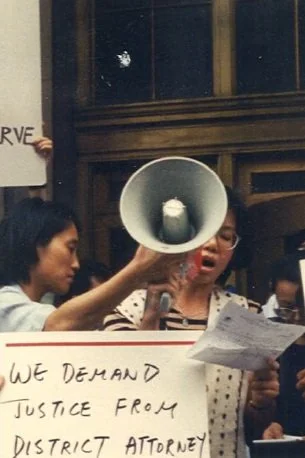Anti-Asian Violence and Acts of Community Care from the 1980s to the Present
Vivian Truong Interviewed by Hongdeng Gao
Today on the Blog, Gotham’s editor Hongdeng Gao speaks with Vivian Truong, author of “From State-Sanctioned Removal to the Right to the City” and a core committee member of the A/P/A Voices: A COVID-19 Public Memory Project. Truong discusses segregationist and police violence against Asian American, Black and Latinx residents in southern Brooklyn in the 1980s and 1990s and the cross-group, cross-issue movements that developed in response to such violence.
Read MoreNew Collections From the CUNY Digital History Archive
By Stephen Brier
The CUNY Digital History Archive (CDHA), created in 2013 by the American Social History Project/Center for Media and Learning at the CUNY Graduate Center, is committed to preserving and presenting on an open publicly accessible website the history of the City University of New York. Over the past eight years, a number of CUNY faculty, staff, graduate students, and alumni have created a series of curated collections of primary historical sources materials on key moments in CUNY’s rich history.
Read MoreThe Bank of United States, East European Jews and the Lost World of Immigrant Banking
By Rebecca A. Kobrin
On a particularly cold morning ninety-one years ago this month, the owner of a small candy store in the Bronx went to his branch of the Bank of United States to withdraw some much-needed cash. Over the past two years, the bank had been selling its shares to its depositors throughout New York city to help raise funds, guaranteeing their investment would maintain its value. The Bank promised it would buy back shares at any point. Now, this storeowner was taking them up on it.
Read MoreDecline, Rebellion, and Police Politics: Rethinking the Dissolution of New York’s Civil Rights Coalition
Reviewed by Joseph Kaplan
In his final book before his life was taken by an assassin’s bullet, Martin Luther King Jr. reflected on the state of the Civil Rights Movement and the conditional allyship of whites. According to King, whites generally believed “that American society is essentially hospitable to fair play and to steady growth toward a middle-class Utopia embodying racial harmony.” Emerging from a decade of unprecedented mobility in which a highly unionized white labor force entered the middle class en masse, many viewed the Civil Rights Movement as part of the unbroken march of progress.
Read More“I have shoes to my feet this time”: May Swenson, New York City, and the FWP
By Margaret A. Brucia
Penniless and hungry, her clothes in tatters, May Swenson was an emergency case for the Workers Alliance (WAA) in March 1938. She was fed at St. Barnabas House on Mulberry Street (“Boy, that butterless bread, gravyless potatoes, hashed turnips & salt-less meatloaf tasted swell!”)[1] and then given fifteen dollars to buy new shoes and clothing at S. Klein’s at Union Square and E 14th Street. “Jesus!” was all she could write in her diary.
Read MoreMuhammad Ali in New York, 1967-1970
By Raymond McCaffrey
On a winter day in February 1967, pedestrians gawked as a young African American man walked along Fifth Avenue in New York City: He stood 6 feet, 3 inches tall, aged twenty-five and he was clearly in fighting shape.[1]
“Is that you, Muhammad Ali?’ one woman exclaimed. “You're so handsome."
Read MoreInterview: Andrea Mosterman on her book, Spaces of Enslavement
Interviewed by Deborah Hamer
In her new book, Spaces of Enslavement: A History of Slavery and Resistance in Dutch New York, Dr. Andrea Mosterman looks at the lives of enslaved people in New Netherland and Colonial New York from the 1620s until 1820. She shows how central enslaved labor was to individual households and to the colony as a whole and how this dependence on enslaved people shaped life for all New Yorkers — Black and white — over this two hundred year period.
Read MorePodcast Interview: Rockaway Blue
Larry Kirwan interviewed by Robert W. Snyder
Twenty years after the terrorist attacks of September 11, 2001, the novel Rockaway Blue (Cornell UP, 2021) probes the griefs, trauma and resilience of Irish American New Yorkers wresting with the deaths and aftershocks of that terrible day. The book weaves throughout New York City, from the Midtown North precinct in Manhattan to Arab American Brooklyn, but it is so grounded in the Irish section of Rockaway in the borough of Queens that Rockaway itself becomes a kind of character.
Read MoreDid All Jews Become White Folks?:
A Fortress in Brooklyn and Hasidic Williamsburg
Reviewed by Gabe S. Tennen
In A Fortress in Brooklyn: Race, Real Estate, and the Makings of Hasidic Williamsburg, Nathaniel Deutsch and Michael Casper add an important wrinkle into prevalent understandings of American Jewish history. Deutsch and Casper focus their text on the Hasidic Satmar sect and its creation of a “holy city of Jerusalem” in one corner of north Brooklyn, tracing that community from its nascent beginnings in the 1940s into the 21st century. By offering a detailed and crisply written account of this often discussed but largely underexamined group, the authors provide a caveat to nearly fifty years of scholarship.
Read More

